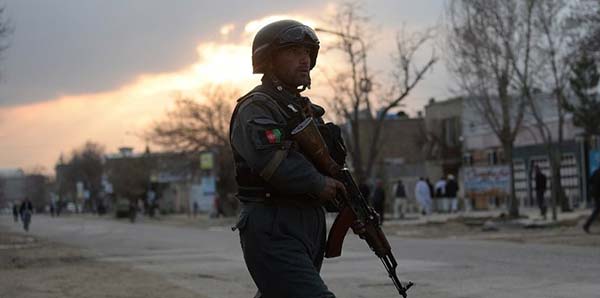There will be security challenges in the upcoming six months, but the capability of security forces is very high. Afghan National Security Forces (ANSF) will destroy the terrorists and will prevent the situation from becoming a crisis.” These words were spoken by Interior Minister Noorulhaq Ulomi on Sunday during an address to the Upper House.
This comes as Afghan police and civilians lose their lives in day-to-day acts of terror. As a result, total civilian deaths and injuries in the first quarter of 2015 followed the record high levels of 2014. Between January 01 and March 31, UNAMA documented 1,810 civilian casualties, a two per cent decrease from the same period in 2014.
“With the seasonal resumption of higher levels of conflict-related violence, the United Nations urges all parties to the conflict to take all necessary measures to protect civilians,” said Nicholas Haysom, the Secretary-General’s Special Representative for Afghanistan and head of UNAMA.
Speaking to the UN News Center on Tuesday June 30, 2015, he warned that the country was facing numerous challenges that will take time to sort out.
Terrorism and instability have plagued the country tremendously. To the Afghans’ unmitigated chagrin, the civilian casualties increase with each passing day in indiscriminate attacks and suicide bombings carried out by the Taliban insurgents – women and children are also among the victims. Moreover, unemployment and economic stagnation – which rule the individuals’ life – are the products of the current turbulence. It is the nature of war to propel a society towards stagnation and greater deadlock. Therefore, Afghan people are wrestling with a number of formidable challenges which root in militancy.
Aimal Faizi, an Afghan journalist and former spokesperson for former president, Hamid Karzai, has written that targeted drone attacks – carried out by the US troops – kill scores of civilians and armed opposition forces alike. These strikes violate Afghan sovereignty and international law, and severely undermine human rights while underscoring the ongoing threat to civilian lives in Afghanistan. So, it is sorry to say that Afghan civilians are killed not only by the Taliban militants but also by the drone attacks. According to him, the ongoing and intensifying drone campaign has “reportedly killed around 400 people in Afghanistan over the last six months.”
He further said, “Beyond the civilian casualties caused by these strikes, drones also fuel terrorism, increase anti-government sentiment and, as a result, increase recruitment opportunities for the armed opposition in Afghanistan.”
Moreover, Nicholas Haysom said on Tuesday that it would be “disastrous” if Afghanistan was forgotten about amid more pressing global issues. On the matter of security, he said that the nature of the challenge is evolving, but that one needs to bear in mind that this is the first year the ANSF have taken sole responsibility of managing the security of the country. Regarding foreign troops, he said Afghanistan has not simply seen a military withdrawal but also an international civilian withdrawal. “There has undoubtedly been an economic contraction with more visible signs of poverty, even in Kabul itself. In the three years that I’ve been in Kabul, there has been a deterioration of security.”
The Afghan national Security Council will have to examine all the drone incidents from the past six months and make its investigation public. Afghans have the right to know how many of their country’s men, women, and children die in these drone strikes. Their government should bring this clarity to them. Additionally, the government is supposed to reach out to the families of victims and provide them with compensation.
The US administration and the Afghan government should take the advice of former US and NATO forces commander in Afghanistan, General Stanley McChrystal, who once rightly said: “For every innocent person you kill, you create 10 new enemies.”
It is likely that war against militancy is a national war that will ebb and flow until the state has both a winning strategy and the relentless determination to implement it. In the war against terror, the state has not really gone beyond the disruption and dismantling of terrorist cells. I believe that this approach does little to address the militancy threat in its many dimensions. Terrorist networks do not exist in isolation — from funding to transport and from hideouts to indoctrination; any given militant group exists and operates with the help of a number of supporting actors. That much-needed support often comes from various elements.
Seemingly, the country will sustain turbulence and economic recession unless a thorough and serious counterterrorism strategy is planned by regional and international communities. The foreign officials have confessed that the US-led NATO anti-terrorism strategy failed in Afghanistan. But I believe that the “war on terror” gave counterproductive result – the emergence of the Islamic State (IS) groups reflects the very bitter fact. Prior to 9/11 attacks, Afghanistan was in the grip of the Taliban’s militancy, however now it is threatened by both Taliban and IS insurgents.
Since Afghan Interior Minister predicts a sinister increase in the Taliban’s insurgency, the government has to take protective measures and intensify the counterterrorism campaign so as to save the country from the verge of collapse. In short, the rhetoric claims against the insurgents will be in vain unless these all come to fruition through action. Afghan people are highly exhausted from war and bloodshed and economic constraints and pray to have their bread and butter in a peaceful environment and have their rights – especially their rights to life, liberty and estate – protected.

